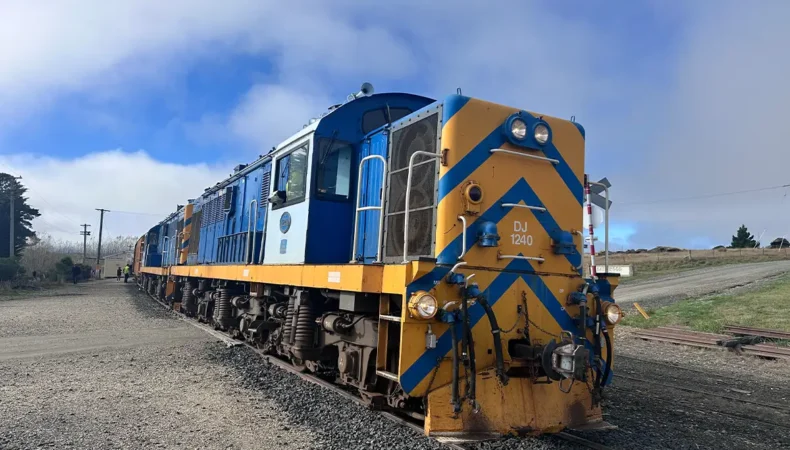The Taieri Gorge Train Journey is one of the NZ’s great train trips and makes the perfect environment to cruise whilst enjoying scenery and off-train experiences. Pulling out of Dunedin, this heritage rail journey provides a rare opportunity to get up close to the region’s engineering wonders and rugged terrain. Whether you love history, the great outdoors or are just looking for a memorable adventure, Taieri Gorge Railway will bring you a unique combination of the two!
We did our Taieri Gorge Train Trip while we were in Dunedin for a 3-day vacation from Christchurch. We booked our tickets a week in advance for NZ$156.77 per adult, but we discovered a coupon code ICE15, which was worth a nice 15% discount at booking (you might use this code at your final order too).
Pre-booking online meant that we had been given pre-assigned seat numbers, so we could just go directly to our carriage without needing to report in.
But if you book at a different outlet and don’t have a seat allocation, go to the railway reception by the station before departure.

Taieri Gorge Train Commentary – Information we Grabbed during the Journey
Those who want to read the information about this rail journey, here is the key information we noted from the live commentary. This will give you some insight into the tour you are doing.
The history of the Taieri Gorge Railway is closely linked to the ‘gold rush’ of the 1860s, which saw the Central Otago area come into its own. Intercolonial Otago had grown to become New Zealand’s largest and wealthiest city, and transport access to the goldfields and farmlands of Central Otago was becoming increasingly important. Otago Central Railway Plans for the Otago Central Railway between Dunedin and Cromwell were drawn up, and construction began in 1879.
The Taieri Gorge section proved an engineering nightmare. The topography was incredibly challenging with precipitous cliffs, deep ravines, and the unforgiving Taieri River. Unabashed, early trailblazers took on the monumental task of dynamiting their way through solid rock and bridging huge chasms. The construction required enormous amounts of labour, much of it in distant and rugged terrain. The workforce was accommodated in temporary camps, consisting of a motley collection of unemployed locals, goldfield drifters and a large number of Chinese labourers.
Progress was painfully slow. The global depression during the 1880s did nothing to ease matters, and in 1883, following four long years, only Hindon had been reached, not even a tenth of the journey to Wanaka. A barrier was the absence of a bridge over the Taioma Stream, a critical bridge to enable ironwork for other bridges to be delivered. The amazing Wingatui Viaduct over the Taioma Stream: The construction contract for this structure was only let in January 1885, but it was completed in 1887. Dating from the 1880s, and still the largest wrought iron structure in New Zealand, it is an iconic part of the trip. By 1890, the first section through the gorge was ready for traffic, but the line to Cromwell was not completed until 1917 and then to its final end in Cromwell in 1921.
Fortunately, the 60km of track through the Taieri Gorge was saved when the line was closed altogether in 1990. Resurrected as a private railway undertaking, the task of delivering a unique rail experience for the tourist and securing its place among the colossal achievements of its constructors.
Pukerangi – The Place Where the Train Stops and reverse its journey

While the Taieri Gorge Railway experience isn’t so much about lots of long stops like a city commuter service. It’s all about the never-ending scenic spectacular happening just outside your window.
But there are usually a few select spots where the train will stop, giving passengers a chance to stretch their legs and take in the atmosphere of the isolated chasm.
Our first stop was at Hindon, a key station during the old gold mine era. You will also find an old train carriage compartment where you can enter and take pictures. Those who find it hard to move between the compartments to get into the train cafe, this is the best place to get your snacks.
After approximately 10 minutes, the strain departs and moves to the final destination, Pukerangi. Here, what you’ll primarily see is the raw beauty of the Otago countryside. It’s an open, exposed area — there are no trees and the ground rolls with a cover of grass and rocky outcrops; the sky is big as all get-out.
Apart from the small station building itself, little built infrastructure is visible, making it easy to fully appreciate the isolation and magnificence of the region.
There is a small station building here, which has pictures and information about the history of the station.

The railway even stops for 10 minutes or so — a perfect time for photographers to get their wide-angle snaps of the train against the dramatic landscape, and for everyone to simply breathe in the clean, fresh air and enjoy the quiet sense of calm that the part of New Zealand is known for.
This is the location where you can also watch the train perform its reversing duties, the engine detaching, moving on its own down a side track, then reconnecting to the other end of the train. This outback stop is where the Taieri Gorge Railway turns around and is a rare on-the-ground view of the workings of a New Zealand railway.
You will also see a couple of local vendors near the platform with their handmade crafts, souvenirs, and snacks, which gives this countryside station a homey & personal touch.
Tour Highlights – Tunnels, Viaducts, Taieri River and the Station Buildings
Tunnels:- You’ll travel through the rugged and spectacular Taieri Gorge, across wrought iron viaducts and through hand-dug tunnels and climb along the banks of the raging Taieri River on this incredible journey. Every time the train goes into a tunnel, there’s a jolt of excitement as the inky darkness momentarily envelopes you, only to emerge and behold another impossibly gorgeous vista. Not only are these tunnels an engineering marvel, but they also speak to the human spirit that wasn’t willing to give up on building a railway through this harsh and unforgiving terrain.
Viaducts:- Another highlight of the journey was crossing the imposing viaducts. The breathtaking buildings soar across gaping canyons and rivers, providing majestic views that are both terrifying and life-affirming. In particular, the size and beauty of the Wingatui and Christmas Creek viaducts are sensational. Sliding gently across them allows ample opportunity to take in the dramatic descent below and the watery glory all around.
Taieri River:- The Taieri River flows gracefully through the gorge, frequently remaining in view of the train as it comes and goes, nature at its very best. Along the way, the sparkling water and meandering route keep them company, a beautiful foil to the craggy cliffs and taunts of rocks. The journey down the river under the bridges and along the valley floor creates a soothing pulse and makes it a highlight in this journey.
Station Buildings:- The historic station buildings at points along the line, such as Hindon and Pukerangi, give the journey more character and flavour. When the Commentator showed us the “World’s Smallest Hotel” building, everyone was surprised to see the actual building. The weathered cottages are little more than glorified wooden sheds that hark back to the halcyon days of rail travel and give an insight into the area’s history. Be it the dated platforms, the old-school signs or the plain log cabins, these stations are reminiscent of yesteryear and a great place to remember.
From Hot Coffee to Toasties: Train Café Information
Another important highlight that makes the Taieri Gorge Railway a special journey is the onboard café. This on-the-go eatery is so much more than a vending machine. It brings comfort and convenience, so you can truly unwind and enjoy the journey without any concern for going hungry or thirsty.
The cafe car is in the middle of the train, available to passengers in all cars to make a quick visit. You have everything for a hot and a cold drink, regardless of the choice of weather or mood.
Apart from hot and cold beverages, the café has a selection of snacks and small food items. This is quite often delicious sweet things, ideal for a bit of personal excess as you rattle over viaducts and optionally being whisked through tunnels.
It’s not a full-service restaurant, but the options are carefully considered to ensure some satisfying bites along the way.
Since there is no network coverage after the train crosses Hindon, the EFTPOS machine won’t work. If you don’t have cash with you, you don’t need to worry. The staff are super friendly and let you give the food without making a pre-payment. Once the train reaches back to Hindon, you can make the payments.
FAQ About Taieri Gorge Train Trip
Which side of the train should to choose to see the best view?
From our experience, if you are getting the right side seats on your way to Pukerangi, that gives the best views. Almost 80% views are on this side. C and D seats give you the best view.
Will the train direction change on your way back from Pukerangi to Dunedin?
No. Only the train engine changes. Which means your side will not change.
Can I change my seats for the Taieri Gorge Train Trip?
Changing Taieri Gorge Train Trip seats depends on the number of people travelling. If you can find empty seats, you are welcome to grab them.
Can I choose the train Seat if I book online?
NO. During the online booking process, there is no option to choose the seats like we do for movies. The seat numbers are auto assigned by the system.
Conclusion
Taieri Gorge Train trip was an unforgettable adventure of stunning sights, interesting railway history and moments of lush tranquillity of New Zealand’s backcountry. From the dramatic cliffs and the twists and turns of the river to the delightful stops at Hindon and Pukerangi, there was something special at every stage of the journey.
As the train wound its way through tunnels and over viaducts, it was exciting yet soothing, and the warm atmosphere on board only enhanced the whole experience. We loved every minute of this adventure and would not hesitate for a moment to recommend it to anyone wanting to experience the “must not miss” sites in Otago.
Last modified: June 12, 2025








